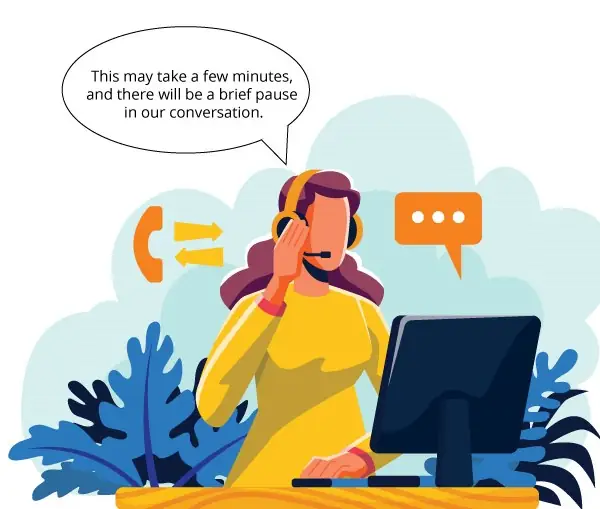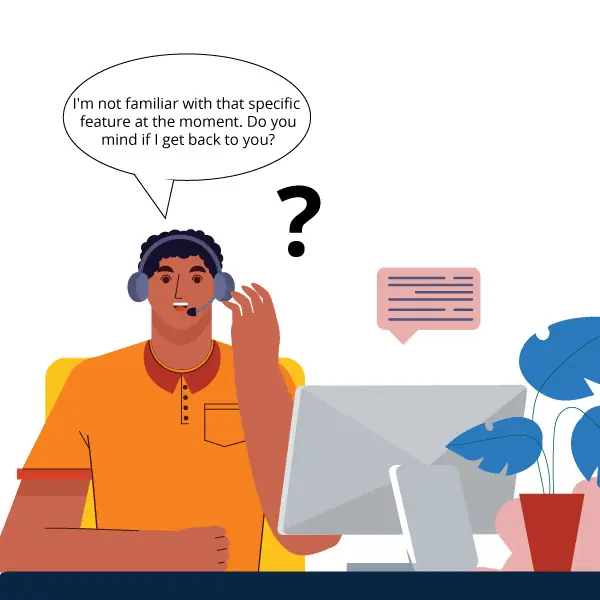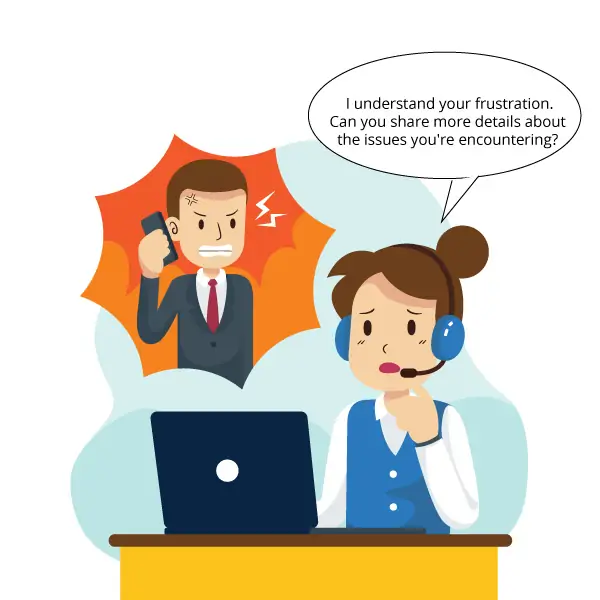Good communication is the lifeline of any call center. Silence on a call can drastically affect the customer's experience. It can often be misinterpreted as disinterest, confusion, or inefficiency, leading to customer dissatisfaction and potential loss of business. Learning how to communicate successfully ensures that customers feel heard, understood, and valued, increasing customer satisfaction and loyalty.
Examples of Silence on a Call
1. When an Agent Is Busy Completing a Task

Silence often happens when an agent is busy completing a task. This could include looking up information or navigating through complex databases to provide the customer with a solution. The customer may feel neglected or out of the loop in these situations.
For example, a customer calls a technical support hotline because they are experiencing issues with their computer software. The agent realizes that troubleshooting the problem will take a few minutes, during which there will be a necessary silence on the call.
In times like these, here are some valuable tips for helping make the customer feel more supported and aware of what is happening:
-
Set Proper Expectations with the Customer
Start by informing your customer of the task you need to perform that might require a pause in your conversation. Explaining the reasons behind the silence enhances customer understanding and patience.
For example, the agent could say, "To address the issue you're facing, I need to perform a detailed analysis of your software. This may take a few minutes, and there will be a brief pause in our conversation."
-
Request Permission to Briefly Put the Call on Hold
Politeness goes a long way in customer service. Ask for the customer's permission to put the call on hold while you complete the task. This shows respect for their time and maintains the conversational rapport.
For example, the agent could say, "I want to ensure I give your concern the attention it deserves. May I have your permission to put the call on a brief hold while I work on resolving the issue? I'll make it as quick as possible."
-
Provide Periodic Updates on the Progress
Keep the customer in the loop about your progress. Minor updates can fill in the silence and ensure the customer that you are actively working on their issue.
For example, after a short pause, the agent returns and says, "Thank you for your patience. I've identified the issue and am currently working on a solution. I'll keep you updated on my progress."
-
Resolve the Task Efficiently and Get Back to the Call Quickly
Efficiency is key. Resolve the task promptly and return to the call as quickly as possible to reassure the customer that their issues matter and are being efficiently addressed.
For example, once the issue has been resolved, the agent says, "I appreciate your patience. I've successfully resolved the software issue. Thank you for waiting. Is there anything else I can assist you with?"
2. When an Agent Doesn't Know the Answer

Another common situation for silence to occur is when the agent does not know the answer to a customer's inquiry instantly. This can create an awkward pause in the conversation, potentially making the customer uncomfortable. Navigating these situations can be tricky, but it is critical to maintain the flow of conversation.
For example, a customer contacts a customer support line with a specific question about a new feature in a software product. The agent, however, is unfamiliar with this feature and doesn't have an immediate answer.
Here are some best practices to avoid the awkward silences:
-
Be Honest and Transparent
Always be honest and transparent. If you don't know the answer, admit it, as customers appreciate honesty over an attempt to deceive.
For example, the agent could say, "I appreciate your question and want to be transparent with you. I'm not familiar with that specific feature at the moment. However, I'm going to find the right information for you. Would it be alright if I took a moment to investigate and get back to you?"
-
Ask for Clarification or Additional Information
Ask for further clarification. This practice not only fills the silence but can also provide additional information that may assist in finding a solution.
For example, the agent asks for clarification by saying, "I want to ensure I provide you with the most accurate information. Could you please provide more details or clarify your question a bit? This will help me better understand your concern and assist you more effectively."
-
Seek Assistance from a Supervisor, Colleague, or Helpdesk
Don't hesitate to seek help from a supervisor, helpdesk, or colleague when in doubt. It's a great way to ensure the customer gets the correct answer.
For example, the agent says, "I want to ensure you receive the best assistance. Since this is a specific feature I'm not entirely familiar with yet, I'll check with my colleague who specializes in this area. Please bear with me for a moment."
-
Promise to Follow Up and Provide a Timeline
When necessary, let the customer know that their query will need a follow-up and provide an accurate timeline for when they can expect an answer. This will reassure the customer that their query has not been overlooked and sets a clear expectation.
For example, the agent could say, "I want to give you the most accurate information, and in order to do so, I need to consult with our technical team. I'll make this a priority and follow up with you by 3 pm this afternoon. I appreciate your understanding as we work to address your question thoroughly."
3. When a Customer is Angry or Frustrated

Unfortunately, silence can also occur when a customer becomes angry or frustrated. Dealing with an angry customer while maintaining a calm and pleasant demeanor can be challenging for an agent.
For example, a customer contacts customer support after experiencing difficulties with a newly purchased electronic device. The frustration is evident in their tone as they express dissatisfaction with the product's performance.
Here are some useful strategies to maintain the flow of communication and calm the situation effectively:
-
Practice Active Listening Techniques
Active listening is vital in diffusing tension and demonstrating to the customer that their concerns are being taken seriously. Agents should:
- Avoid interrupting the customer.
- Paraphrase their concerns to ensure understanding.
- Ask clarifying questions if necessary.
- Use words to acknowledge listening (i.e., yes, okay, I see, hmmm, uh-huh)
For example:
Customer: "This device is not working as promised, and I've wasted so much time trying to figure it out!"
Agent: "I understand your frustration. I want to make sure I grasp the specifics. Can you share more details about the issues you're encountering? This will help me address your concerns more effectively."
-
Allow for a Natural Pause After the Customer has Finished Speaking
Agents should wait for a pause in the conversation to make sure that the customer has finished saying what they wanted to say. Often, when customers have a complaint, they have a script in their head about what they want to say, and it's crucial for agents not to interrupt them before they are done.
For example, agents should wait for the customer to stop speaking before asking any clarifying questions or before answering the customer.
-
Apologize and Take Responsibility
It's important to apologize if the company or agent made a mistake. Owning up to errors can rebuild customer trust and pave the way for problem-solving.
For example, if there has been a mistake on behalf of the company, the agent could say, "I'm sincerely sorry for the inconvenience you've experienced. Clearly, we've fallen short of your expectations, and we take full responsibility for that. Please allow me the opportunity to make things right for you."
-
Offer Solutions and Alternatives
Ultimately, providing solutions to the customer's issues will help move the conversation forward and bridge silence efficiently. Present alternative solutions if the primary option is not feasible. The key is to leave the customer feeling satisfied and heard.
For example, an agent could say, "I apologize for the frustration caused by the device's performance. To address this, I can guide you through troubleshooting steps, or if that doesn't resolve the issue, we can explore a replacement option. What works best for you, and how can I assist you further to ensure your satisfaction?"
Reviewing and Analyzing Call Recordings
Call recordings are invaluable for understanding the nature and cause of silence during calls. They offer a wealth of information and can provide insights into agents' strengths and areas for improvement. Analyzing call recordings can identify patterns and common reasons behind periods of silence.
Once you've identified the typical causes of silence, you're better equipped to provide personalized training and mentorship to the agents. Teach them to handle silence effectively, whether by using good communication skills to calm an angry customer, quickly sourcing the necessary information, or multitasking efficiently.
